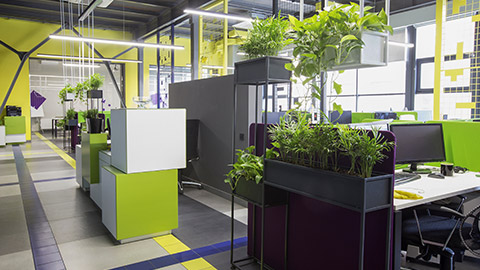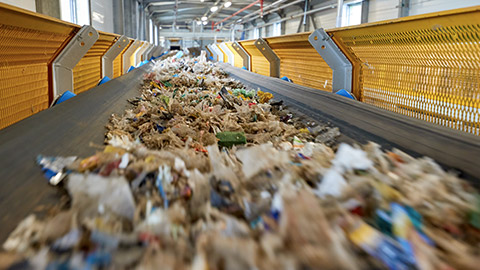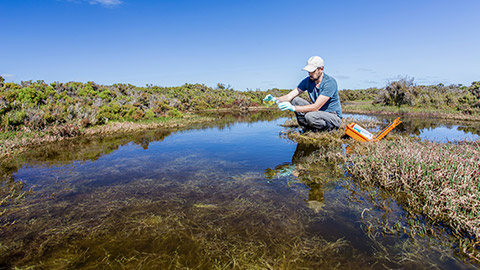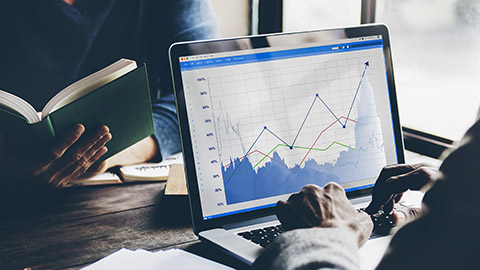Reading
Check out these articles:
Connect the dots on ESG metrics, from water and emissions to social and governance indicators in your operations and supply chain. https://www.adecesg.com/what-we-do/esg-metrics/
In business today, it is a requirement to demonstrate continuous improvement in environmentally sustainable practices and meet legislation demands. For this to occur, a business needs to first look at the systems they have in place for sustainability and design a plan to improve on areas of work practice. Changes need to be monitored and reviewed to ensure progress is being made. Documentation and recording of improvement are necessary to demonstrate and track progress.
This module discusses how to determine the specific requirements so that workplaces can align their strategies with best practices, management systems and monitoring processes, and work towards continuous, sustainable improvements.
Watch
Next watch this video from Ted Talks Frank Wijen discussing Sustainable Business.
Sustainability in business refers to a company's strategy to reduce negative environmental impact resulting from their operations in a particular market. An organization's sustainability practices are typically analyzed against environmental, social, and governance (ESG) metrics.
Before you can assess whether your organisation is compliant in areas of sustainability, you first need to understand what sustainability is. Let's begin by exploring the concept of Sustainability in the business concept.
What is Sustainability in the Workplace?

In 1987, the term sustainability was explained by the Bruntland Commission Report as focusing on ‘how we use our world and its resources now and the impacts that it will have on ourselves, but mostly on future generations and the health of the world’.
Sustainability can involve all aspects of one’s life including thinking and acting in a sustainable way throughout the daily routines, processes, practices and systems of an organisation. In other words, always consider how the actions of the business impact the planet.
Environmentally sustainable management means that you are aware of how your business affects (or has the potential to affect) the environment and that you take actions that lead to continuous improvement toward minimising your environmental footprint.
The word sustainability is commonly discussed and implemented at many levels around the world, but what does it really mean? Many people describe sustainable in several ways and have different feelings and attitudes about its relevance, need for existence, importance and how to be sustainable. To be sustainable, it is important to know what sustainability looks like in action.
Reading: Examples of sustainability in the workplace
Read the blog post, 6 Examples of Sustainability in the Workplace (And Their Impact), to learn more about what sustainability can look like in different workplaces
Watch
Watch this video, explaining how to be sustainable in the workplace, focusing on the impact of business in the environment. This is also known as ‘Green Skills’ or ‘Green Imitative’.
Watch
Next watch this video explaining sustainability in business operation, looking at the concept of the Triple Bottom Line. We will be exploring this in the module.
Benefits of Workplace Sustainability
Sustainability is considered the long-term goal, whereas environmental responsibility refers to the short-term thoughts, actions and operational processes developed by an organisation to become sustainable in the long-term. Sustainable development supports the changes, pathways and steps we take to become sustainable or the development that supports the present needs without compromising the needs of future generations.
As well as being environmentally responsible, making your business more sustainable has many benefits, including:
- Cost savings: Sustainable practices lower costs by minimising energy, water, wastage and materials.
- Business reputation: Customers and other stakeholders are eager to see and use businesses that support environmentally responsible practices and may be more likely to support your business when you work sustainably.
- Resource recovery: Reducing, reusing and recycling can be economically more profitable and is also an important element for economic and environmental sustainability.
- Work health and safety: Workplaces can see improved health and safety by reducing the use of hazardous substances and minimising waste.
- Legal compliance: Businesses that work towards meeting environmental protection laws will be deemed compliant.
Reading: Why Your Business Needs a Sustainability Plan
A well-thought-out sustainability plan assists a company in operating its business responsibly while achieving a healthy bottom line.Coyle, F 2015
Read the article, Why Your Business Needs a Sustainability Plan, from ADEC innovation, which outlines three key advantages for sustainable businesses.
Watch
The next video is an explanation about how business can change the world.
Business Commitment to Sustainability

Two terms are commonly used to describe the ways in which businesses can demonstrate and measure their commitment to sustainability:
- Environmental, social and governance (ESG)
- Corporate social responsibility (CRS)
Environmental, Social and Governance (ESG)
ESG is a framework based on quantifiable assessment measures for sustainable business practices. Using ESG as a strategy to develop or monitor sustainable practices involves setting measurable goals and using clearly defined performance metrics to determine whether the goals were achieved. ESG strategies and assessments encourage businesses to act ethically. ESG strategies cover the following three areas:
- Environmental: policies and procedures related to energy and water use, emissions and climate change, and the management and treatment of animals.
- Social: policies and procedures related to interactions with stakeholders other than investors, such as employees and community relationships.
- Governance: policies and procedures related to board and executive diversity, and compensation, and ethical accounting and financial reporting (Lutkevich B 2023).
Corporate Social Responsibility (CSR)
CSR is a business model that aims to improve the environmental and social conditions for everyone through ethical corporate behaviour. Although more qualitative than ESG, good CSR improves morale and maintains good brand reputation (Lutkevich B 2023).
Components of Sustainability

While sustainability can be applied to almost every aspect of a business, the three core pillars of sustainability are generally accepted as:
- Economic (profit)
- Social (people)
- Environmental (planet)
Together, the three pillars are often referred to as the triple bottom line to show that there are three equal priorities to improve the overall economic value of a business.
WATCH
What this video explaining the 3 Pillars of Sustainability.
Reading
Read the article, ESG vs. CSR vs. sustainability: What’s the difference?, to learn more about the three terms and how they are related.
Economic Pillars of Sustainability
Economic sustainability refers to practices designed to create the long-term economic development of a company or nation while also managing the environmental, social, and cultural aspects of its activities.
Prysmian Group n.d.
Economic sustainability balances making a profit with impacts on people and the environment.
Businesses cannot afford to behave unsustainably. If they use up all natural and human resources, then they cannot continue to function. Instead, economic sustainability ensures the organisation can continue to function and grow. Economic sustainability also brings several benefits to businesses, including reducing:
- energy waste, which increases savings
- staff turnover through better social practices (Prysmian Group n.d.).
Social Pillar of Sustainability
Humans need to have the desire and understanding to support the impacts of corporations or the world on people and society. Social sustainability seeks to improve the quality of life and provide high quality education for all people and societies. It supports community development and equal opportunity. While laws govern societies, our ethics and morals determine social sustainability.
Social sustainability includes the conservation of cultural beliefs, cultural practices, heritage and culture as its own entity. The aim is to ensure that the existence of different cultures and their unique set of beliefs, morals, methods and collection of human knowledge will exist in the context of the future.
In business, social sustainability is about valuing the relationships with employers, employees and other stakeholders and the social value of the organisation’s processes and methods. These should be an important part of any business strategy and may include areas such as:
- Human rights
- Fair work
- Living conditions
- Health, safety and wellbeing
- Inclusion, diversity and equity
- Work/life balance
According to the UN Global Compact, aiming for social sustainability can help businesses in several ways, including:
- Unlocking new markets
- Helping retain and attract business partners
- Becoming the source of innovation for new product or service lines
- Raising internal morale and employee engagement
- Improving risk management
- Improving company-community conflicts.
What is Social Sustainability?
Nobel prize-winning economist Laureate Amartya Sen describes social sustainability as having five dimensions:
- Equity
- Diversity
- Social cohesion
- Quality of life
- Democracy and governance.
Read the article, What is Social Sustainability?, from ADEC Innovations, which explains these dimensions.
Environmental pillar of Sustainability

When people hear ‘sustainability’, most will think about environmental sustainability. Environmental sustainability involves the balance between natural resource use and conservation to ensure long-term quality and availability of the natural resources.
Natural resources include:
- clean air and water
- fossil fuels, such as oil and natural gas
- building materials, such as sand and rock
- fertile soil
- plants and animals
WATCH
Watch this video explaining what is environomental sustainability and its importance.
WATCH
The next video is a Ted Youth talk about Environmental Sustainability.
WATCH
Watch another Ted Talk from Annick Schmeddes explaining the concept of Sustainable Leaders and how everyone can be a sustainability leader.
Environmental sustainability is reliant on action; talking about it does not make it better supported and build a healthier, more sustainable world, though it does engage more awareness. Sustainability involves small steps that build to big steps and by exploring humans’ perceptions and treatment of the environment, observing how they have altered and threatened the very survival of humanity, demonstrates the need for our workplaces and future generations to embed responsible responses as soon as possible.
UNESCO is the United Nations Educational, Scientific and Cultural Organization. It seeks to build peace through international cooperation in Education, the Sciences and Culture. UNESCO’s programmes contribute to the achievement of the Sustainable Development Goals defined in Agenda 2030, adopted by the UN General Assembly in 2015.
UNESCO 2020
The sustainable development goals are a blueprint to achieve a better ands sustainable future for everyone. The goals were devised as a way to address the global challenges we face today, including those related to:
- poverty
- inequality
- climate change
- environmental degradation
- Peace
- Justice
And so much more.
There are 17 goals that were developed to be the international standard and benchmark against which every country and every workplace can compare themselves. The goals were developed to be interconnected, and in order to leave no one behind. UNESCO is aiming to help achieve the goals by 2030.
WATCH
Next watch this animation video explaining what are the sustainable development goals from UNESCO.
Select each SDS goal to learn more about them.
- End poverty in all its forms everywhere
- End hunger, achieve food security and improved nutrition and promote sustainable agriculture
- Ensure healthy lives and promote well-being for all at all ages
- Ensure inclusive and equitable quality education and promote lifelong learning opportunities for all
- Achieve gender equality and empower all women and girls
- Ensure availability and sustainable management of water and sanitation for all
- Ensure access to affordable, reliable, sustainable and modern energy for all
- Promote sustained, inclusive and sustainable economic growth, full and productive employment and decent work for all
- Build resilient infrastructure, promote inclusive and sustainable industrialization and foster innovation
- Reduce inequality within and among countries
- Make cities and human settlements inclusive, safe, resilient and sustainable
- Ensure sustainable consumption and production patterns
- Take urgent action to combat climate change and its impacts
- Conserve and sustainably use the oceans, seas and marine resources for sustainable development
- Protect, restore and promote sustainable use of terrestrial ecosystems, sustainably manage forests, combat desertification, and halt and reverse land degradation and halt biodiversity loss
- Promote peaceful and inclusive societies for sustainable development, provide access to justice for all and build effective, accountable and inclusive institutions at all levels
- Strengthen the means of implementation and revitalize the Global Partnership for Sustainable Development
Watch
Watch the following video Stocktaking/ What it will take to achieve the Sustainable Development Goals? by the United Nations.
Individual Ecological Footprint

An ecological footprint estimates how the world can biologically produce or reproduce the earth’s resources within the ratio of how much we use. It refers to how much of an impact—i.e. footprint—we leave behind due to our effect on the world and changes we make.
WATCH Watch this small animation explaining the concept of The Ecological Footprint.
Legislation, standards and policy guidance for businesses
While every individual contributes to sustainability, developing policies and procedures for entire businesses to follow tends to have a greater impact.
Watch
Watch this quick video to help give you a refresher on policies and procedures for business.
Australia has over 50 legislations that are relevant to environmental sustainability today and many of these are under review at the time of production of this content. In 1999, the Australian Government’s Environment Protection and Biodiversity Conservation Act 1999 (Cwth) was set forward (and commenced in 2000), providing ‘a legal framework to protect and manage nationally and internationally important flora, fauna, ecological communities and heritage places defined in the Act as matters of national environmental significance’.
They inform that the objectives of the EPBC Act (Cwth) are to:
- provide for the protection of the environment, especially matters of national environmental significance
- conserve Australian biodiversity
- provide a streamlined national environmental assessment and approvals process
- enhance the protection and management of important natural and cultural places
- control the international movement of plants and animals (wildlife), wildlife specimens and products made or derived from wildlife
- promote ecologically sustainable development through the conservation and ecologically sustainable use of natural resources
- recognise the role of Indigenous people in the conservation and ecologically sustainable use of Australia’s biodiversity
- promote the use of Indigenous peoples’ knowledge of biodiversity with the involvement of, and in cooperation with, the owners of the knowledge.
In 2013, an amendment occurred which embedded the importance of ‘making water resources a matter of national environmental significance, in relation to coal seam gas and large coal mining development’.
The Environment Protection (Vehicle Emissions) Regulations 2013 aim to minimise the negative effects of noise and emissions from motor vehicles by providing compliance information on air emissions (grossly polluted vehicle rule and diesel emission standards) and noise standards (noise tests and engine speeds) for vehicles on the road.
Learn more about the role of the Department of Climate Change, Energy, the Environment and Water (DCCEEW) in administering the EPBC Act by reviewing the Our role in protecting the environment under the EPBC Act webpage.
You can also explore more resources specifically related to climate change, including Australia’s climate change strategies and Emissions reporting, at the DCCEEW Climate change webpage.
Local Sustainability Legislation
It is important to note that each state and territory will also have their own coinciding legislations and codes. Use the hyperlinks to view each of the following examples.
| State or Territory | Sustainability Acts, Codes and Guidelines |
|---|---|
| Australian Capital Territory |
|
| New South Wales | |
| Northern Territory | |
| Queensland | |
| Tasmania | |
| South Australia | |
| Victoria | |
| Western Australia |
Reading: EPA Environmental Principles, Factors and Objectives
To learn more about how the Western Australian EPA functions, read their Statement of Environmental Principles, Factors and Objectives.
Licenses and Permits
Each business is different and has different uses of the Earth’s resources and hence, impacts on these. Many businesses need specific licenses or permits to allow their business to operate.
Read the article, Referrals and environmental assessments under the EPBC Act, to learn more about the process of applying for permission to conduct a project that may have environmental impact.
Principles
The following Environmental Principles (2020) were created in line with the Environmental Protection Act 1986 (Cwth) and Australian Environmental policies. The principles are:
| Principles | Definition |
|---|---|
|
Ecological integrity and maintaining biological diversity (Biodiversity) |
Conservation of biological diversity and ecological integrity should be a fundamental consideration. This includes protecting all life forms; plant, animals and microorganisms understanding their intense interconnection in terms of each other’s survival. |
| Integrating environmental, social and economic considerations in decision- making | Environmental factors should be included in the valuation of assets and services (economy), including those generating pollution and waste. Users of goods and services should bear these costs. Environmental goals, having been established, should be pursued in the most cost-effective way, by establishing incentive structures, including market mechanisms, which enable those best placed to maximise benefits or minimise costs to develop their own solutions and responses to environmental problems. |
| Precautionary behaviour | Where there are threats of serious or irreversible damage, lack of full scientific certainty should not be used as a reason for postponing measures to prevent environmental degradation. In the application of the precautionary principle, decisions should be guided by careful evaluation and assessment of risk (risk management) to avoid, where practicable, serious or irreversible damage to the environment. |
| Equity for each generation and between generations | The present generation should ensure that the health, diversity and productivity of the environment is maintained or enhanced for the benefit of future generations (quality of life). |
| Waste minimisation | All reasonable and practicable measures should be taken to minimise the generation of waste and its discharge into the environment. |
| Democracy and governance | The process of informing participation and transparency of communities in situations of potential impact on actions. |
| Involving the community | Collaboration and involvement of communities’ work towards long-term goals for sustainability. |
| Continual improvement | Continual improvement is required for sustainability processes including the containing, minimising use of natural resources and production of damaging elements such as plastics and reviewing the impacts of elements, such as waste and environment pollutants. |
| Emissions | Actively identify and implement (where practical) improvements to minimise the production of greenhouse gases through our everyday activities. |
| Consumption | Actively identify and implement (where practical) improvements to minimise consumption and promote efficient use of energy, water, paper and other material inputs. |
| Transport | Consider environmental factors when purchasing and using fleet vehicles and travel sustainably when practical. |
| Infrastructure | Ensure all new capital works programs and office relocations incorporate comprehensive environmental sustainability principles. |
| Compliance | Comply with all relevant environmental legislation, regulations and policies. |
| Monitoring | Monitor and review your environmental performance against annually reviewed targets. Improve the quality of data collected and reported. |
| Communication | Communicate our environmental performance to all staff and stakeholders while encouraging participation and feedback. |
Policies
When developing a workplace sustainability policy, it is important to tailor to the needs of your organisation. Several policy templates are freely available online and you can sometimes access the policies of similar businesses as a point of comparison.
For example:

For example, review and compare the partially completed template Environmental Sustainability Policy from the Institute of Community Directors Australia with the final.
Diverse thinking about Sustainable Practices

In any workplace, there will be different views about sustainability, its relevance and importance in the business world. It is important that all stakeholders understand the broad benefits of engaging in environmentally responsible practices, both in a business and environmental sense. Variations in views may be due to experience, interest, education, generational influence and culture. For example, Aboriginal and Torres Strait Islander people have a slightly different take on sustainability given their intrinsic and spiritual connection to the earth, land, water, air, community, flora, fauna and ecosystems:
We believe that Country is not only the Land and People, but is also the Entities of Waterways, Animals, Plants, Climate, Skies and Spirits. Within this, one Entity should not be raised above another, as these live in close relationship with one another. So People are no more or less important than the other Entities
Martin & Mirraboopa, 2003, p. 207
Aboriginal and Torres Strait Islander people use practices to read the environment and provide what the earth needs for survival, which is ultimately the survival of their own communities. They have always used sustainable practices in their everyday management of the land and understand the interconnectedness and interdependence of all life forms. Some common examples include placing plants where needed to sustain environments, using fire for controlling ecosystems, and knowing when to fish, hunt and harvest. Aboriginal and Torres Strait Islander people consider the regeneration and cycles and patterns as law, and interrupting this is seen as an act against the laws of nature. They are always considering a sustainable concept known as the survival of seven generations.
Watch
Next watch this small video explaining Aboriginal Sustainability and how they created sustainability thousands of years ago.
Ron (Deganadus) McLester, Executive Director and Special Advisor to the President on Aboriginal Initiatives, explains the sustainability concept of Seven Generations in the following video.
First Nations Sustainability Concepts

| Concept | Explanation |
|---|---|
| Mother Earth as a Life-Giving Force | In many First Nations languages, Mother Earth is depicted as a living person. If the inhabitants of this world continue to desecrate her, then she will no longer be a life-giving force. |
| Laws of Nature | There was a time and season for all life-sustaining activities. Animals were not killed during their reproductive cycles. |
| Life-Sustaining Elements of the World |
Air: The essential element of human and all life forms. It also is the means by which one thinks and speaks. Earth: Provides food and many other life-sustaining materials and resources. Fire: Provides heat and light. The Sun is fire. Water: Cools and nurtures, makes life and growth possible. Balance among the four basic elements, the innate capacities of humankind and the life-sustaining elements of nature makes it possible to live well and comfortably. |
| Interrelationships and Interconnectedness | Take no person, animal, or thing for granted. Everyone and everything has a role and a place. |
Watch
Next watch this video explaining What is Indigenous Land Management by Scope TV.
Legal duties and codes of practice
Each state and territory have individual requirements regarding business licensing, operations, sustainable practice and environmental responsibility to ensure the prevention of environmental harm, nuisances and contamination.
Each business will have a legal obligation and duty to these conditions, which apply to all businesses. Non-compliance can result in offences set by the jurisdictional environmental authority (EA).
View your state or territory’s environmental code of practice and EA for more information.
The following are hyperlinks to some examples of state-based guidelines.
- Business Queensland:
- EPA Victoria:
- DCCEEW:
Determine Legislative and Regulatory Requirements Relevant to the Work Area
As discussed previously, there are several pieces of legislation, regulations and standards relating to sustainability. To determine the aspects that apply to your business and specific work area, you must be able to accurately analyse these types of documents.
Activity: Analyse texts to determine legislative and regulatory requirements
How to assess organisational compliance
Watch
Watch this video made by Younique Training to explain what is compliance/ organisational compliance and why is it important.
Here is another video explaining business compliance from another perspective.
Once you have identified the compliance requirements, legislation, regulations, standards and codes of practice that are relevant to your organisation and specific work area, you must then assess the extent to which the business is compliant.
While the exact process of determining organisational compliance will depend on the business and the practices you are investigating, the following are the general, broad steps you would take.
- Identify all compliance requirements for the practice, including relevant legislation, regulations and codes of practice.
- Collect data on environmental efficiency and sustainability of the current practice.
- Analyse data and identify areas for improvement.
- Consult with stakeholders and external sources for best practice sustainable processes.
- Develop efficiency targets and methods to monitor progress.
- Implement the new operational practices and procedures.
- Assess the outcomes of the new processes using the monitoring tools and method developed.
The Australian Government provides support and general guidance for environmental management in business. Explore the Manage your environmental impact webpage for more details and relevant links.
Data Collection and Audit Practices

There are many methods for assessing how the business is managing environmental systems and working sustainably.
These may include:
- Conducting internal audit on each commodity that uses paper
- Manual estimates
- Power meters
- Measuring by using recycling records to determine the change per month
- Reviewing purchase orders over a period of time
- A comparison of the bills by the energy provider
- Using a waste contractor to weigh the waste amount or calculate by volume
- Getting an external independent audit.
Every workplace will have competing priorities, including when it comes to sustainability development. The organisation may have mission statements, procedures and policies regarding their priorities for sustainability, just as they have for other areas, such as WHS. These support the knowledge, streamline implementation and awareness of KPIs and targets for sustainable actions and requirements in practice. Depending on the business, different directions may be evident; these might relate to costing procedures, approvals and sales systems.
For example, stage gating systems may be implemented to decide whether the target is related to a particular product, product range or all areas of the business and how the customer or client has driven or encouraged the goals. A stage gating system is a business road map that is designed to move a new product or project from idea to launch. Breaks or ‘gates’, where the leadership assess and approve each phase, are included in the plan. Concept, development, industrialise and launch phases are common phases in the stage gating system. In between these stages there will also be costings approvals, where the business will assess the costs and benefits of implementing sustainable strategies.
Data Collection
Data collection is the process of finding out numerical information about various sustainability practices or environmental impacts. Some common areas to audit include:
- Emissions, such as greenhouse gases and carbon dioxide
- Consumption patterns, such as of utilities or finite consumables
- Waste production, such type and amount of disposable items.
Watch
Next watch this video explaining the concept of Data and how businesses can collect data.
Emissions

Emissions is a collective erm used to account for all harmful gases, such as greenhouse gases and carbon dioxide, produced directly or indirectly by a business and its activities.
Greenhouse gases are substances that move into the atmosphere and trap heat against the Earth’s surface in a process called the greenhouse effect. Increases amounts of greenhouse gases increase the amount of heat that the atmosphere can trap, causing the enhanced greenhouse effect and contributing to global warming. Even tiny increases to the planet’s overall temperature causes climate change, where long-term, consistent weather conditions and patterns are shifting and becoming unpredictable.
Carbon dioxide (CO2) is one of the main greenhouse gases and is produced by the burning of wood, petroleum, oil and natural gas.
Monitoring and reducing CO2 emissions is a critical step in reducing global warming and climate change.
The Clean Energy Regulator provide several spreadsheet templates to help businesses to calculate their emissions, solid waste and wastewater production.
Consumption Patterns

Consumption patterns are the trends in the types of items and the number or amount of each consumable that is used in a particular process or by a business as a whole. To determine consumption patterns, you can collect data from purchasing histories or stock inventories. You may discover consumption trends can change cyclically - for example, electricity usage may be higher in winter months than in summer.
Waste Production

A waste audit examines the types and amounts of items that are thrown away – typically over a 24-hour period. The disposal systems are evaluated in terms of effectiveness of source separation. The items are classified according to relevant requirements of the workplace, for example as recyclable, landfill, or compostable. Specific types of waste are then measured in terms of number of items or by weight.
Waste audit data includes information about:
- Waste diversion rate – the quantity of waste that is diverted from landfill, such as by upcycling, recycling or composting.
- Capture rate – the quantity of recyclable materials that make it into the recycling program successfully. In other words, checking the amount of recyclable materials that end up going to landfill.
- Contamination rate – the quantity of non-recyclable materials that are disposed of in recycling bins and recyclable materials that are disposed of in the incorrect recycling bin. Highly contaminated recycling loads cannot be recycled and so will end up in landfill (Brown 2022).
Waste audits are a great way to identify where staff education is required to support correct waste disposal.
Reading: EPBC approvals
To learn more about waste audits, read the article, What is a waste disposal audit?.
Activity: Waste management
- Download the Commercial Waste Management Plan (WMP) – instructions and form provided by the City of Melboune.
- Assess your current workplace and complete the form according to the data.
Watch
Let’s watch a short video from the office of sustainable practices explaining a waste audit.
In summary, an environmental audit is a management system where a tool is used to systematically, objectively and periodically evaluate and document environmental performance in the workplace in line with set outcomes or requirements. This assesses risk, controls and improves areas within the workplace. You might like to create your own audit or self-assessment checklist relating to areas of your business’s environment impact, using the environmental principles as a guide.
Analyse the data

Once you have collected your data, you need to analyse it to draw conclusions and identify areas for improvement.
EMS and Reliable Data
It is beneficial to have an environmental managements system (EMS) to collect and analyse your data. This ensures consistency in how processes of measurement and analysis are conducted. More reliable conclusions can be drawn if you consistently use the same approach to collecting data.
Long term trends can be accurately determined if you collect data from the same work areas in the same manner over several time periods. you could compare results from the same department over different months or years or compare the data from different departments or processes.
Using graphs to present data can make trends visually clear, making them easier to understand and share with stakeholders.
WATCH
Let’s watch this short video explaining the concept behind a EMS.
Analyse Data
After collecting data, you should analyse it and review your organisation’s practices and strategies in line with the environment principles.
You may wish to analyse such areas as:
- General waste
- Hazardous and chemical waste management
- Land requirements
- Energy use
- Vehicle use
- Water use
Areas for improvement are easily identified where the data does not meet the sustainability requirements or targets. If you have long-term data or historical audits to analyse, you can determine trends or patterns in the data. The trends may show improvements, no change or a decline in sustainability.
You can use trend data to monitor progress of sustainable work practices.
Analysing numerical data requires several techniques, depending on the type and source of data involved. Some common calculations required for analysing sustainability data include:
- measuring water and electricity use
- calculating metric measurements
- calculating quantities
- calculating ratios
- financial calculations.
Measuring Water Use

Water usage is measured in kilolitres (kL). 1 kL is 1 000 litres. Every residence and business place has a water meter that measures the amount of water that is used by the premises. To calculate water usage, you need to know how to read the water meter. The following video, How to read your water meter and check for leaks (2:06 min), is an easy guide to help you measure water use.
Three methods can be used when measuring water in the workplace.
Method 1: Water bill
Read your water bill. The water bill will tell you exactly how much water has been used within a specific period.
Method 2: Calculator tools
You can calculate your daily average water usage using an online calculator tool, such as those provided by Sydney Water. The tool allows you to enter calendar dates or number of days in a period, total water usage amount or water bill information to calculate the average amount of water used each day in the period you are looking at. You can also do these calculations yourself.
For example, assume that your total water usage for a billing period of 30 days was 5.25 kL and you want to know what your average daily use is. Simply divide the total usage by the number of days in the billing period. Remember that 1 kL = 1 000 L!
Method 3: Meter measurements
First, use read the water meter to calculate the volume of water used each day in the period you wish to calculate. You should read the meter at the same time each day during this period.
To document your measurements, it is best to create a table. You may wish to do this digitally or with pen and paper. Make sure to plan the number of columns and rows you will need and include appropriate headings and units.
The following table is an example of a record of water meter readings over a period of four days. The first day you record the reading is Day 0, because you can’t calculate the usage for this day. It just gives you a starting point for the measured usage.
| Day | Time | Water meter reading (kL) |
|---|---|---|
| Day 0 | 8 am | 5 250 |
| Day 1 | 8 am | 5 500 |
| Day 2 | 8 am | 6 012 |
| Day 3 | 8 am | 6 020 |
| Day 6 | 8 am | 6 040 |
Next, calculate the difference between consecutive days to get the total usage for the previous day. Then add all the daily usage amounts to calculate the total usage for the period. Examples of these calculations have been demonstrated in the following table, using the data collected in the previous table.
| Day | Calculation | Total daily water use |
|---|---|---|
| Day 1 |
(Day 1 reading) (Day 0 reading) 5 550 - 5 250 kL |
= 250 kL |
| Day 2 |
(Day 2) (Day 1) 6 012 - 5 550 kL |
= 462 kL |
| Day 3 |
(Day 3) (Day 2) 6 020 - 6 012 kL |
= 8 kL |
| Day 4 |
(Day 4) (Day 3) 6 040 - 6 020 kL |
= 20 kL |
| Total usage for this period | 250 + 462 + 8 + 20 = 790 kL |
Finally, now that you have the total water usage for the period, you can calculate the average daily usage using the same equation from Method 2.
While this method takes longer, it allows you to determine the days you are using the most amount of water. From these calculations, you can see that the most amount of water used was on day two.
Measuring Electricity

Electricity is measured in Watts (W). The equivalent three methods can be used to measure electricity as to measure water usage:
Method 1: Electricity bill
Reading your electricity bill. The electricity bill will tell you exactly how much electricity has been used within a specific time.
Method 2: Calculator tools and devices
Calculate the energy use or annual running cost of any appliance within the workplace using an online appliance electricity cost calculator, such as the one provided by Reduction Revolution. The electrical cost calculator allows you to work out how much electricity is being used by one appliance over a year.
You can also buy an appliance power meter. A power meter is a device that plugs into the wall socket and the appliance is then plugged into the power meter. The power meter measures the amount of electricity (energy) used by the appliance that is plugged in.
Method 3: Meter measurements
First, use read the electricity meter to calculate the amount of energy used each day in the period you wish to calculate. You should read the meter at the same time each day during this period.
To document your measurements, create a table with the appropriate number of columns and rows. Don’t forget to include headings and units where necessary.
The following table is an example of a record of electricity meter readings over a period of four days. Remember that Day 0 is to work out the starting point for the measured usage.
| Day | Time | Electrical meter reading |
|---|---|---|
| Day 0 | 8 am | 2 500 W |
| Day 1 | 8 am | 3 500 W |
| Day 2 | 8 am | 3 750 W |
| Day 3 | 8 am | 4 080 W |
| Day 4 | 8 am | 5 000 W |
Next, calculate the difference between consecutive days to get the total usage for the previous day. Then add all the daily usage amounts to calculate the total usage for the period. Examples of these calculations have been demonstrated in the following table, using the data collected in the previous table.
| Day | Calculation | Total daily energy use |
|---|---|---|
| Day 1 |
(Day 1 reading) - (Day 0 reading) 3 500 – 2 500 W |
= 1 000 W |
| Day 2 |
(Day 2) - (Day 1) 3 750 – 3 500 W |
= 250 W |
| Day 3 |
(Day 3) - (Day 2) 4 080 – 3 750 W |
= 330 W |
| Day 4 |
(Day 4) - (Day 3) 5 000 – 4 080 W |
= 920 W |
| Total usage for this period | 1 000 + 250 + 330 + 920 = 2 500 W |
Finally, now that you have the total electrical usage for the period, you can calculate the average daily usage using the following formula.
As with calculating water usage, this method of measuring usage provides more detail around differences in usage across the period being examined.
How to Calculate Metric Measurements
In business sustainability, metrics play a crucial role in assessing and managing the environmental, social, and economic impacts of an organization. Using metric measurements helps businesses track progress, set targets, and communicate their sustainability performance. Here are key metric categories commonly used in business sustainability, along with examples:
| Metric | Example | |
|---|---|---|
| Energy Efficiency | Energy Consumption (kWh) | Measure and reduce the total energy consumption of facilities and operations. |
| Water Usage | Water Consumption (cubic meters) | Monitor and minimize water usage in production processes and facilities. |
| Carbon Footprint | CO2e Emissions (metric tons) | Quantify and reduce greenhouse gas emissions from operations, transportation, and supply chains. |
| Waste Management | Waste Generation (metric tons) | Track and reduce the amount of waste produced by the business, promoting recycling and waste diversion. |
| Supply Chain Sustainability | Supply Chain GHG Emissions (metric tons CO2e) | Assess and improve the sustainability of suppliers, including their environmental and social practices. |
| Renewable Energy Usage | Percentage of Energy from Renewable Sources | Increase the share of energy derived from renewable sources within the organization. |
| Social Impact | Community Investment (financial contribution or volunteer hours) | Measure and report on the positive social impact within communities where the business operates. |
| Employee Well-being | Employee Satisfaction Index | Assess and enhance employee well-being, job satisfaction, and work-life balance. |
| Product Life Cycle Assessment | Life Cycle Environmental Impact (e.g., kg CO2e per unit) | Evaluate and minimize the environmental impact of products from raw material extraction to disposal. |
| Sustainable Procurement | Percentage of Sustainable Inputs | Increase the procurement of materials and services with verified sustainability credentials. |
| Circular Economy Metrics | Percentage of Recycled/Reused Materials | Embrace circular economy principles by measuring and increasing the use of recycled or reused materials. |
| Financial Performance | Return on Sustainable Investments | Evaluate the financial returns associated with sustainability initiatives and investments. |
| Diversity and Inclusion | Diversity Index | Measure and improve diversity and inclusion within the workforce, leadership, and decision-making processes. |
| Regulatory Compliance | Number of Environmental Violations | Ensure compliance with environmental regulations and track the number of violations. |
| Customer and Stakeholder Engagement | Stakeholder Satisfaction Index | Assess and enhance relationships with customers, suppliers, and other stakeholders. |
Choosing the right combination of these metrics depends on the specific industry, business goals, and stakeholder expectations. Regularly monitoring and reporting these metrics can help businesses demonstrate their commitment to sustainability and drive continuous improvement.
How to Calculate Quantities
To measure water and energy usage, you measure the flow of the resource into the workplace as a whole or to a specific appliance. However, many resources are used in discrete units, such as reams of paper, cans of dog food or number of bolts.
To measure the usage of these types of resources it can be easier to examine ordering invoices or record every time a new packet is opened.
For example, to calculate the average amount of paper used per person, per day you need to find out the total amount of paper used during a certain period. You can do this by recording the amount of paper that is used over a period, say a month, and then dividing this number by the number of days in the period. This will give you the daily average usage of the resources. Then divide the daily average usage by the number of personnel who use that resource to calculate the average amount per person, per day. You can then use figure like these to compare work areas or compare efficiencies of different procedures.
How to calculate ratios
Ratios are numerical relationships or proportions between two or more variables. In business and finance, ratios are commonly used to analyze and interpret financial statements, assess performance, and make informed decisions. These ratios provide insights into various aspects of a company's operations, financial health, and efficiency. Here's an explanation of different types of ratios commonly used in business:
- Liquidity Ratios: These rations assess a companies ability to meet its short term financial goals and obligations.
- Profitability Ratios: Are used to evaluate a companies ability to generate profits relating to revenue, assets and equity
- Efficiency Ratios: Is used to measure how effective a company utilizes its assets and resources to generate sales and profit
- Debt Ratios: Help to evaluate a companies leverage/ debt levels relative to its assets, equity and income
- Investment Valuation Ratios: Helps investors to assess the attractiveness of a companies stocks and investment opportunities
So now you have an understanding of how ratio’s work in a business sense, next let’s have a look at how it relates to business sustainability.
Watch
Watch this video to help you get a quick introduction to ratios.
Ratios in the context of business sustainability provide insights into how effectively a company integrates environmental, social, and governance (ESG) considerations into its operations, performance, and decision-making processes. These ratios help stakeholders assess the sustainability performance and impact of a company, identify areas for improvement, and make informed decisions about investing, partnering, or doing business with the company. Here's an explanation of some key ratios in relation to business sustainability:
Environmental Performance Ratios
Environmental performance ratios assess a company's impact on the environment and its efforts to mitigate environmental risks and promote sustainability. Common environmental ratios include:
- Carbon Intensity: Measures the amount of greenhouse gas emissions (e.g., CO2e) generated per unit of revenue, output, or production.
- Water Intensity: Measures the amount of water consumed or withdrawn per unit of output, revenue, or production.
- Waste Intensity: Measures the amount of waste generated per unit of output, revenue, or production.
- By analyzing these ratios, stakeholders can evaluate a company's environmental efficiency, resource management practices, and progress towards reducing its environmental footprint.
Social Impact Ratios
Social impact ratios assess a company's contributions to social welfare, human rights, and community development. Common social impact ratios include:
- Diversity and Inclusion Ratios: Measure the representation of diverse groups within the workforce, leadership, and governance structures.
- Employee Turnover Rate: Measures the percentage of employees leaving the company within a given period, reflecting employee satisfaction and retention.
- Community Investment Ratio: Measures the amount of financial contributions or volunteer hours allocated to community development initiatives relative to revenue or profit.
- By analyzing these ratios, stakeholders can assess a company's commitment to social responsibility, employee well-being, and community engagement.
Governance Effectiveness Ratios
Governance effectiveness ratios assess the quality of a company's corporate governance practices and its adherence to ethical standards and regulatory requirements. Common governance effectiveness ratios include:
- Board Diversity Ratio: Measures the representation of diverse backgrounds, skills, and experiences on the company's board of directors.
- CEO-to-Worker Pay Ratio: Compares the compensation of the CEO to the average or median pay of workers within the organization.
- Ethical Conduct Ratio: Measures the number of ethics violations or incidents relative to total revenue or profit.
- By analyzing these ratios, stakeholders can evaluate the transparency, accountability, and ethical behavior of a company's leadership and governance structures.
Sustainability Integration Ratios
Sustainability integration ratios assess the extent to which sustainability considerations are integrated into the company's core business strategies, operations, and decision-making processes. Common sustainability integration ratios include:
- ESG Integration Score: Measures the degree to which environmental, social, and governance factors are incorporated into investment decisions or business practices.
- Sustainability Reporting Ratio: Measures the comprehensiveness and transparency of the company's sustainability reporting practices relative to industry peers.
- Sustainability Leadership Index: Evaluates the company's reputation, performance, and leadership in sustainability compared to industry peers or benchmarks.
- By analyzing these ratios, stakeholders can gauge the maturity, alignment, and effectiveness of a company's sustainability strategy and management practices.
These ratios provide stakeholders with valuable insights into the holistic sustainability performance and impact of a company, enabling them to make informed decisions, drive positive change, and promote sustainable business practices. By integrating sustainability considerations into financial analysis and decision-making processes, stakeholders can foster greater transparency, accountability, and long-term value creation for both businesses and society.
How to Calculate Financial Information

Before we look into financial information and how it helps to provide data around business sustainability let us first look at what kind of financial information you may encounter from a business perspective.
Calculating financial information involves using various formulas and methods to analyze data from a company's financial statements. Here's a step-by-step guide on how to calculate some key financial metrics:
Gather Financial Statements:
- Obtain the company's financial statements, including the income statement, balance sheet, and cash flow statement. These documents provide the necessary data to calculate financial ratios and metrics.
Income Statement Analysis:
- Calculate Gross Profit: Gross Profit = Revenue - Cost of Goods Sold (COGS)
- Calculate Operating Income: Operating Income = Gross Profit - Operating Expenses
- Calculate Net Income: Net Income = Operating Income - Taxes - Interest Expense
Balance Sheet Analysis:
- Calculate Total Assets: Total Assets = Total Current Assets + Total Non-current Assets
- Calculate Total Liabilities: Total Liabilities = Total Current Liabilities + Total Non-current Liabilities
- Calculate Shareholders' Equity: Shareholders' Equity = Total Assets - Total Liabilities
Liquidity Ratios:
- Calculate Current Ratio: Current Ratio = Current Assets / Current Liabilities
- Calculate Quick Ratio: Quick Ratio = (Current Assets - Inventory) / Current Liabilities
Profitability Ratios:
- Calculate Gross Profit Margin: Gross Profit Margin = (Gross Profit / Revenue) * 100
- Calculate Net Profit Margin: Net Profit Margin = (Net Income / Revenue) * 100
- Calculate Return on Assets (ROA): ROA = (Net Income / Total Assets) * 100
- Calculate Return on Equity (ROE): ROE = (Net Income / Shareholders' Equity) * 100
Efficiency Ratios:
- Calculate Inventory Turnover: Inventory Turnover = Cost of Goods Sold / Average Inventory
- Calculate Accounts Receivable Turnover: AR Turnover = Revenue / Average Accounts Receivable
Debt Ratios:
- Calculate Debt-to-Equity Ratio: Debt-to-Equity Ratio = Total Debt / Shareholders' Equity
- Calculate Interest Coverage Ratio: Interest Coverage Ratio = Operating Income / Interest Expense
Cash Flow Analysis:
- Calculate Operating Cash Flow: Operating Cash Flow = Net Income + Non-cash Expenses (e.g., depreciation) - Changes in Working Capital
- Calculate Free Cash Flow: Free Cash Flow = Operating Cash Flow - Capital Expenditures
Investment Valuation Ratios:
- Calculate Price-to-Earnings (P/E) Ratio: P/E Ratio = Market Price per Share / Earnings per Share
- Calculate Price-to-Book (P/B) Ratio: P/B Ratio = Market Price per Share / Book Value per Share
Sustainability Ratios:
- Depending on the sustainability metrics of interest, you can calculate various ratios such as carbon intensity (CO2 emissions per unit of revenue), water intensity (water usage per unit of production), or diversity ratios (e.g., percentage of women in leadership positions).
- Always ensure the accuracy and completeness of the data used in your calculations. It’s also essential to compare calculated ratios to industry benchmarks or historical trends to provide context and aid in interpretation. Additionally, consider the limitations and assumptions inherent in financial calculations and ratios when making decisions based on the results.
Watch
Watch this video explaining financial statements which relate to financial information you would find with a business.
Calculating financial information related to business sustainability involves analyzing data from a company’s financial statements and sustainability reports to assess its environmental, social, and governance (ESG) performance. Here’s a guide on how to calculate financial information specifically related to business sustainability:
Gather Financial and Sustainability Data:
- Obtain the company’s financial statements, including the income statement, balance sheet, and cash flow statement, as well as its sustainability reports or disclosures.
- Collect additional data related to sustainability initiatives, such as energy consumption, carbon emissions, water usage, waste generation, social impact programs, diversity metrics, and governance practices.
Identify Key Sustainability Metrics: Determine the key sustainability metrics relevant to the company’s industry, operations, and stakeholder expectations. These may include:
- Environmental Metrics: Carbon emissions, energy usage, water consumption, waste generation, and pollution levels.
- Social Metrics: Employee turnover rates, diversity and inclusion statistics, community investment, labor practices, and human rights.
- Governance Metrics: Board diversity, executive compensation, ethics violations, regulatory compliance, and transparency measures.
Calculate Environmental Performance Indicators: Calculate carbon intensity by dividing total carbon emissions (CO2e) by revenue, production output, or another appropriate measure of business activity.
- Determine energy intensity by dividing total energy consumption by revenue, production output, or square footage of facilities.
- Calculate water intensity by dividing total water usage by revenue, production output, or number of employees.
- Assess waste intensity by dividing total waste generation by revenue, production output, or number of products manufactured.
Analyse Social Impact Indicators:
- Calculate employee turnover rates by dividing the number of employees who left during a period by the average number of employees.
- Assess diversity ratios by calculating the percentage of women, minorities, or other underrepresented groups in leadership positions or across the workforce.
- Measure community investment by quantifying financial contributions, volunteer hours, or in-kind donations to community development projects or charitable organizations.
Evaluate Governance Effectiveness:
- Calculate the CEO-to-worker pay ratio by dividing the CEO’s total compensation by the median or average compensation of all employees.
- Assess board diversity by calculating the percentage of women, minorities, or independent directors on the company’s board of directors.
- Measure transparency and accountability by analyzing the completeness and quality of sustainability reporting and disclosures.
Integrate Financial and Sustainability Metrics:
- Integrate sustainability metrics with financial performance indicators to assess the financial implications of sustainability initiatives.
- Analyze the impact of sustainability efforts on cost savings, revenue generation, risk mitigation, brand reputation, and stakeholder engagement.
- Consider the long-term value creation potential of sustainability investments and initiatives in financial decision-making processes.
Compare and Benchmark:
- Compare calculated sustainability metrics to industry benchmarks, sector averages, or historical performance to assess the company's relative performance and identify areas for improvement.
- Benchmark against best practices and industry standards to set targets, goals, and performance thresholds for sustainability performance.
By following these steps, businesses can effectively calculate financial information related to business sustainability, enabling them to assess their ESG performance, communicate their sustainability efforts to stakeholders, and drive continuous improvement in sustainability practices and outcomes.
Activity: Analysing sustainability data
Resources:
Identifying sources and collecting information is the next step on positive sustainable practices, which can be shared with your workplace. Further information for environment support, products or advice can be found at the following links:
- Australian Conservation Foundation
- Department of Climate Change, Energy, the Environment and Water, Climate services and tools
- Business Council for Sustainable Development Australia

Based on your data analysis and sustainability requirements, you should be able to identify areas for improvement. Some key organisational systems and procedures that relate to environmental and resource sustainability improvements, include:
- Supply chain, procurement and costing strategies
- Quality assurance
- Recommendation development and seeking approvals
- Sales strategies and operations.
Supply Chain, Procurement and Costing Strategies

Supply chain management, procurement, and costing strategies play critical roles in shaping business sustainability efforts. These interconnected functions influence the environmental, social, and economic impacts of a company's operations throughout its supply chain. Here's an explanation of each and how they relate to business sustainability:
Supply Chain Management
- Supply chain management involves the planning, sourcing, manufacturing, and distribution of goods and services from suppliers to customers.
- Sustainable supply chain management focuses on integrating environmental, social, and economic considerations into all stages of the supply chain to minimize negative impacts and create value for stakeholders.
- Practices such as responsible sourcing, green procurement, efficient transportation, and waste reduction help improve supply chain sustainability.
- For example, companies may work with suppliers who adhere to environmental and labor standards, optimize transportation routes to reduce emissions, and implement recycling programs to minimize waste generation.
Drawing on leading practices in the field, and addressing environmental, social, and governance issues, the SAQ is a “conversation starter” for companies to use with their suppliers as they begin to assess the sustainability risks in their supply chains.Ceres 2012 Download a copy of the SAQ from Ceres to learn more about it and use in your own supply chain assessments.
Procurement
- Procurement refers to the process of sourcing goods and services from external suppliers to meet the organization's needs.
- Sustainable procurement involves selecting suppliers and products based not only on cost and quality but also on their environmental and social performance.
- Companies can prioritize suppliers with sustainable practices, such as those with certifications for responsible sourcing, fair labor practices, or low carbon emissions.
- Additionally, sustainable procurement may involve establishing supplier codes of conduct, conducting supplier audits, and fostering long-term partnerships with suppliers committed to sustainability.
Costing Strategies
- Costing strategies determine how costs are allocated and managed within the organization, including production costs, overhead expenses, and supply chain costs.
- Sustainable costing strategies take into account the full lifecycle costs of products and services, including environmental and social externalities.
- Practices such as activity-based costing, life cycle costing, and total cost of ownership analysis help capture and incorporate sustainability-related costs into decision-making.
- For example, by considering the environmental impacts of different materials or production processes, companies can identify cost-effective opportunities to reduce resource consumption, minimize waste, and improve overall sustainability performance.
Relationship to Business Sustainability
-
Environmental Impact Reduction: Sustainable supply chain management, procurement, and costing strategies contribute to reducing environmental impacts by promoting resource efficiency, minimizing waste generation, and lowering carbon emissions throughout the supply chain.
-
Social Responsibility: By prioritizing suppliers with fair labor practices and safe working conditions, companies uphold social responsibility standards and contribute to better working conditions and human rights protection within their supply chains.
-
Risk Management: Integrating sustainability into supply chain management, procurement, and costing strategies helps mitigate risks associated with environmental regulations, supply chain disruptions, reputational damage, and stakeholder activism.
-
Innovation and Competitive Advantage: Adopting sustainable practices in supply chain management, procurement, and costing can drive innovation, enhance brand reputation, and create competitive advantages by meeting customer demands for environmentally friendly and ethically sourced products and services.
-
Long-term Value Creation: By considering environmental and social factors alongside financial considerations, businesses can enhance long-term value creation by fostering resilience, promoting stakeholder trust, and positioning themselves for success in a rapidly evolving marketplace.
Supply chain management, procurement, and costing strategies are essential components of business sustainability efforts. By integrating environmental, social, and economic considerations into these functions, companies can minimize risks, drive innovation, enhance competitiveness, and create long-term value for both their business and society as a whole.
Quality Assurance
In the realm of business sustainability, organisational systems relating to quality assurance ensure that sustainable practices are effectively implemented, monitored, and improved upon within Australian businesses. Here are some key elements of such systems:
- ISO Standards Compliance: Many businesses adhere to International Organization for Standardization (ISO) standards such as ISO 14001 (Environmental Management Systems) and ISO 9001 (Quality Management Systems) to establish frameworks for managing sustainability and quality assurance processes.
- Sustainability Policies and Procedures: Establishing clear policies and procedures outlining the organization's commitment to sustainability and quality assurance is crucial. These documents define roles, responsibilities, and processes for implementing sustainable practices across various business functions.
- Training and Capacity Building: Providing training and development opportunities for employees on sustainability principles, best practices, and quality assurance processes ensures that staff are equipped with the knowledge and skills needed to support sustainability initiatives effectively.
- Performance Monitoring and Reporting: Implementing systems to monitor and track key sustainability metrics allows organizations to assess their performance against targets and identify areas for improvement. Regular reporting on sustainability and quality assurance performance ensures transparency and accountability to stakeholders.
- Internal Audits and Reviews: Conducting regular internal audits and reviews of sustainability and quality assurance systems helps identify gaps, non-conformities, and opportunities for improvement. These audits ensure that processes are aligned with organizational objectives and regulatory requirements.
- Supplier and Supply Chain Management: Establishing robust systems for evaluating and managing the sustainability performance of suppliers and partners is essential for ensuring that the entire supply chain adheres to sustainable practices and quality standards.
- Continuous Improvement Processes: Implementing mechanisms for capturing feedback, lessons learned, and innovative ideas enables organizations to continuously improve their sustainability and quality assurance practices over time. This may involve regular reviews, feedback mechanisms, and formal improvement initiatives.
- Stakeholder Engagement: Engaging with stakeholders such as customers, regulators, investors, and community groups is integral to understanding their expectations and incorporating their feedback into sustainability and quality assurance strategies.
- Risk Management: Integrating sustainability and quality assurance considerations into risk management processes helps identify and mitigate potential risks associated with environmental, social, and economic factors.
- Certification and Recognition: Seeking certification from independent bodies or participating in sustainability awards programs can provide external validation of an organization's commitment to quality assurance and sustainability best practices.
Australian businesses can effectively manage risks, drive performance improvements, and demonstrate their commitment to environmental and social responsibility by implementing robust organisational systems relating to quality assurance in business sustainability.
Recommendation Development and Seeking Approvals

Developing recommendations for business sustainability initiatives involves a structured approach to identifying opportunities, evaluating their feasibility and impact, and seeking approvals from relevant stakeholders. The two main areas to focus on are:
- Recommendation development
- Seeking approval
Recommendation Development
Recommendation development is the process of formulating actionable suggestions or proposals aimed at addressing specific challenges, achieving objectives, or improving outcomes within an organization. In the context of business sustainability, recommendation development involves identifying opportunities to enhance environmental, social, and economic performance and proposing initiatives to support sustainable practices. Here's an explanation of the key steps involved in recommendation development:
Identify Objectives and Challenges:
- Begin by clearly defining the objectives you aim to achieve through sustainability initiatives. These objectives could relate to reducing carbon emissions, minimizing waste generation, improving resource efficiency, enhancing social impact, or aligning with sustainability standards and regulations.
- Identify the key challenges or barriers that may be hindering progress towards these objectives. This could include factors such as limited resources, technological constraints, regulatory constraints, or stakeholder resistance.
Gather Information and Data:
- Conduct research and gather relevant information and data to inform your recommendations. This may include analyzing current sustainability practices, benchmarking against industry standards and best practices, conducting stakeholder consultations, and assessing the potential impact of various initiatives.
- Utilize quantitative and qualitative data to identify trends, patterns, and areas of opportunity for improvement.
Brainstorm Potential Solutions:
- Facilitate brainstorming sessions with cross-functional teams or stakeholders to generate ideas and potential solutions to address the identified objectives and challenges.
- Encourage creativity and innovation in exploring different approaches, technologies, and strategies that could contribute to sustainability goals.
Evaluate Options and Prioritise:
- Evaluate the feasibility, effectiveness, and potential impact of each proposed solution against predefined criteria such as cost-effectiveness, scalability, alignment with organizational values, and stakeholder acceptance.
- Prioritize the recommendations based on their potential to address the most significant challenges or opportunities, achieve the desired objectives, and deliver tangible benefits.
Develop Actionable Recommendations:
- Translate the prioritized ideas into actionable recommendations with clear objectives, targets, and implementation plans.
- Specify the resources, timelines, and responsibilities required for each recommendation, ensuring alignment with the organization's capabilities and strategic priorities.
- Consider potential risks, constraints, and contingencies, and incorporate mitigation measures into the recommendations.
Communicate and Gain Buy-In:
- Present the recommendations to relevant stakeholders, including senior management, decision-makers, and key influencers, using clear and compelling communication techniques.
- Highlight the rationale, benefits, and potential outcomes of each recommendation, emphasizing the business case for sustainability and the value proposition for the organization.
- Address any questions, concerns, or objections raised by stakeholders and seek their input and buy-in to ensure alignment and support for the proposed initiatives.
Refine and Finalize Recommendations:
- Incorporate feedback from stakeholders and decision-makers to refine and finalize the recommendations, ensuring that they are practical, achievable, and well-supported.
- Document the finalized recommendations in a clear and comprehensive format, including supporting data, analysis, and justification for each recommendation.
Monitor and Evaluate Progress:
- Implement the approved recommendations according to the agreed-upon action plans and timelines.
- Establish monitoring and evaluation mechanisms to track progress, measure performance against targets, and assess the effectiveness of the sustainability initiatives.
- Continuously review and adapt the recommendations based on feedback, changing circumstances, and emerging opportunities to ensure ongoing improvement and success.
By following these steps, organizations can effectively develop recommendations for business sustainability initiatives that are well-informed, actionable, and aligned with their goals and objectives.
Seeking Approval
Seeking approvals is an essential part of implementing any significant initiative within an organisation, including those related to business sustainability. It involves obtaining formal consent or authorisation from relevant stakeholders, such as senior management, board of directors, regulatory bodies, or other decision-makers, before proceeding with the proposed actions. Here's an explanation of the concept for seeking approvals in the context of business sustainability:
- Ensuring Alignment: Before seeking approvals, it's crucial to ensure that the proposed sustainability initiatives align with the organization's strategic objectives, values, and priorities. This alignment helps demonstrate the relevance and importance of the initiatives to the organization's overall mission and vision.
- Building a Compelling Business Case: Develop a comprehensive business case that outlines the rationale, benefits, and expected outcomes of the proposed sustainability initiatives. The business case should articulate how the initiatives contribute to the organization's long-term success by addressing key challenges, seizing opportunities, and enhancing competitiveness.
- Engaging Stakeholders: Engage with key stakeholders throughout the approval process to gather input, address concerns, and build support for the proposed initiatives. Stakeholders may include senior management, department heads, employees, investors, customers, suppliers, regulators, and community members. Tailor your communication strategy to each stakeholder group to ensure their specific interests and priorities are considered.
- Presenting Recommendations: Present the recommendations for sustainability initiatives in a clear, concise, and persuasive manner. Clearly articulate the objectives, targets, timelines, and expected outcomes of each initiative, supported by relevant data, analysis, and evidence. Anticipate potential questions or objections from stakeholders and be prepared to address them effectively.
- Addressing Concerns and Obtaining Feedback: Encourage open dialogue and address any concerns or objections raised by stakeholders during the approval process. Listen actively to feedback, clarify misunderstandings, and provide additional information or reassurance as needed. Incorporate stakeholder feedback into the recommendations to enhance their credibility and acceptance.
- Navigating Regulatory Requirements: Ensure compliance with applicable laws, regulations, and industry standards when seeking approvals for sustainability initiatives. Be aware of any regulatory requirements or approval processes that may apply to specific initiatives and proactively address them to mitigate risks and ensure legal compliance.
- Documenting Approvals: Once approvals have been obtained from relevant stakeholders, document them in writing to provide clarity and accountability. Formal approval documentation should include details such as the approved initiatives, associated budgets and resources, designated responsibilities, and agreed-upon timelines for implementation.
- Establishing Monitoring and Reporting Mechanisms: Establish mechanisms for monitoring progress, tracking performance, and reporting on the outcomes of approved sustainability initiatives. Regularly communicate updates and achievements to stakeholders to maintain transparency and accountability throughout the implementation process.
By following these steps, organizations can effectively navigate the process of seeking approvals for business sustainability initiatives, ensuring that proposed actions are well-supported, properly authorized, and successfully implemented to drive positive change and create value for the organization and its stakeholders.
Sales Strategies and Operations

Sales strategies and sales operations play a crucial role in driving the adoption and success of business sustainability initiatives. These strategies and operations focus on promoting sustainable products and services, communicating their value proposition to customers, and ensuring alignment with the organisation's sustainability goals.
Sale Strategies
Sales strategies encompass the plans and actions implemented by businesses to achieve their sales objectives and drive revenue growth. When it comes to sustainability, sales strategies are tailored to promote products or services that offer environmental, social, or economic benefits. Here's an elaboration on sales strategies in the context of business sustainability:
Targeted Marketing and Positioning:
- Sustainable sales strategies often begin with targeted marketing efforts aimed at specific customer segments interested in environmentally friendly or socially responsible products.
- Businesses leverage market research to identify and understand the preferences, values, and purchasing behavior of sustainability-conscious consumers.
- Through effective positioning and messaging, sales teams emphasize the unique sustainability attributes of their products or services, appealing to the values and preferences of their target audience.
Value Proposition Development:
- Sustainable sales strategies focus on developing a compelling value proposition that highlights the benefits and advantages of choosing sustainable products or services.
- Sales teams articulate how sustainability features such as energy efficiency, recyclability, ethical sourcing, or social impact contribute to cost savings, risk reduction, brand enhancement, or regulatory compliance for customers.
- By emphasizing the value that sustainability delivers, sales teams differentiate their offerings in the marketplace and persuade customers to make purchasing decisions aligned with sustainability goals.
Consultative Selling Approach:
- Sustainability-focused sales strategies often adopt a consultative selling approach, where sales professionals act as trusted advisors to customers, helping them navigate complex sustainability challenges and opportunities.
- Sales teams engage in dialogue with customers to understand their sustainability priorities, assess their needs and challenges, and co-create solutions that align with their objectives.
- Through collaborative problem-solving and solution-oriented discussions, sales professionals build long-term relationships with customers, earning their trust and loyalty while driving sales of sustainable products or services.
Education and Awareness Building:
- Sustainable sales strategies involve educating customers about the importance of sustainability and the benefits of choosing environmentally friendly or socially responsible options.
- Sales teams provide information and resources to help customers understand the environmental, social, and economic impact of their purchasing decisions.
- By raising awareness and fostering a deeper understanding of sustainability issues, sales professionals empower customers to make informed choices that support their sustainability goals while driving sales.
Incentives and Rewards Programs:
- To encourage adoption of sustainable products or services, sales strategies may incorporate incentives and rewards programs that incentivize customers to choose sustainability.
- Businesses offer discounts, rebates, loyalty points, or other incentives to customers who purchase sustainable products or take environmentally friendly actions.
- By providing tangible benefits for choosing sustainability, sales teams create incentives for customers to make sustainable purchasing decisions, driving sales while advancing sustainability goals.
Partnerships and Collaborations:
- Sustainable sales strategies leverage partnerships and collaborations with other organizations, such as suppliers, distributors, NGOs, or industry associations, to expand market reach and amplify impact.
- Sales teams collaborate with partners to co-develop sustainable solutions, access new markets, share resources and expertise, and leverage collective influence to drive systemic change.
- By working together with stakeholders across the value chain, sales professionals enhance their ability to promote sustainable products or services effectively and drive sales growth.
Measurement and Evaluation:
- Sustainable sales strategies incorporate measurement and evaluation mechanisms to track the effectiveness and impact of sustainability-focused sales initiatives.
- Sales teams monitor key performance indicators such as sales of sustainable products, customer satisfaction with sustainability attributes, market share of sustainable offerings, and revenue generated from sustainability-focused initiatives.
- By analyzing sales data and performance metrics, sales professionals gain insights into the effectiveness of their strategies, identify areas for improvement, and optimize their approach to drive sustainable sales growth.
In summary, sustainable sales strategies involve targeted marketing, value proposition development, consultative selling, education and awareness building, incentives and rewards programs, partnerships and collaborations, and measurement and evaluation. By integrating sustainability into their sales approach, businesses can drive revenue growth while advancing environmental and social objectives.
Sales Operations
Sales operations in the context of business sustainability involve the practical execution and management of sales activities that promote sustainable products or services, align with sustainability goals, and drive positive environmental, social, and economic outcomes. Here's an elaboration on sales operations in relation to business sustainability:
Product and Service Offerings:
- Sales operations begin with defining and curating product and service offerings that embody sustainability principles. This may involve working closely with product development teams to ensure that offerings are designed with environmental, social, and economic considerations in mind.
- Sales professionals play a role in communicating the sustainability features and benefits of these offerings to customers, highlighting how they address specific sustainability challenges or meet the needs of sustainability-conscious consumers.
Customer Relationship Management (CRM):
- Effective sales operations rely on robust CRM systems to manage customer relationships and track interactions related to sustainable sales efforts.
- Sales teams use CRM tools to capture customer preferences, track purchasing behavior, and segment customers based on their sustainability interests and priorities.
- By leveraging CRM data, sales professionals can personalize their approach, tailor product recommendations, and deliver targeted messaging to customers interested in sustainability.
Lead Generation and Prospecting:
- Sales operations involve generating leads and identifying prospects who are likely to be interested in sustainable products or services.
- Sales teams utilize various channels such as digital marketing, social media, trade shows, and networking events to reach potential customers and raise awareness about sustainability offerings.
- By targeting leads with a demonstrated interest in sustainability or related topics, sales professionals can maximize the effectiveness of their prospecting efforts and increase the likelihood of converting leads into customers.
Sales Process Optimization:
- Sales operations focus on optimizing the sales process to streamline efficiency, improve effectiveness, and maximize sales of sustainable products or services.
- This may involve defining clear sales workflows, standardizing sales procedures, and implementing automation tools to eliminate manual tasks and reduce administrative overhead.
- By optimizing the sales process, sales teams can allocate more time and resources to engaging with customers, addressing their needs, and driving sustainable sales growth.
Training and Development:
- Sales operations invest in training and development programs to equip sales professionals with the knowledge, skills, and resources needed to effectively sell sustainable products or services.
- Training may cover topics such as sustainability principles, product knowledge, customer engagement techniques, objection handling, and value-based selling approaches.
- By investing in ongoing training and development, sales organizations ensure that their teams are well-prepared to articulate the value proposition of sustainability and address customer inquiries or concerns effectively.
Performance Measurement and Analytics:
- Sales operations utilize performance measurement and analytics tools to track the effectiveness and impact of sustainability-focused sales efforts.
- Key performance indicators (KPIs) may include metrics such as sales revenue generated from sustainable products, customer satisfaction with sustainability attributes, conversion rates for sustainability-focused leads, and market share of sustainable offerings.
- By analyzing sales data and performance metrics, sales professionals gain insights into the success of their sustainability initiatives, identify areas for improvement, and make data-driven decisions to optimize sales operations.
Continuous Improvement and Innovation:
- Sustainable sales operations are characterized by a commitment to continuous improvement and innovation.
- Sales teams regularly evaluate sales processes, performance metrics, customer feedback, and market trends to identify opportunities for innovation and optimization.
- By fostering a culture of continuous learning and improvement, sales organizations can stay ahead of the curve, adapt to changing market dynamics, and drive sustained growth in sustainable sales.
Sales operations in relation to business sustainability encompass product and service offerings, customer relationship management, lead generation and prospecting, sales process optimization, training and development, performance measurement and analytics, and continuous improvement and innovation. By integrating sustainability principles into sales operations, businesses can effectively promote sustainable products or services, engage with sustainability-conscious customers, and drive positive impact while achieving sales objectives.
Smart Efficiency Targets
Once a business understands their environmental improvement needs, they will need to make a plan to minimise impact or improve systems. First a goal, target or an environmental commitment needs to be set, along with strategies to achieve this goal and a realistic timeline for achievement. SMART goals can be successful as they are evidence-based by requiring each goal to be:
- Specific: Be clear and specific so your goals are easier to achieve. This also helps you know how and where to get started!
- Measurable: Measurable goals can be tracked, allowing you to see your progress. They also tell you when a goal is complete.
- Actionable: Are you able to take action to achieve the goal? Actionable goals ensure the steps to get there are within your control.
- Realistic: Avoid overwhelm and unnecessary stress and frustration by making the goal realistic.
- Timebound: A date helps us stay focused and motivated. Inspiring us and providing something to work towards.
The Plan, Do, Check, Act (PDCA) cycle is a system that supports the process of ensuring sustainability from beginning to end. This can help to make the journey one that is ongoing and has systematic processes and steps to achieve the results required.
The PDCA cycle involves:
- Plan: Identify and understand the problem or opportunity. State the success criteria for the possible solution and make it measurable.
- Do: Test the solution with a small-scale pilot project. This shows if your proposed changes will achieve the desired outcomes. Gather data to see if the change has worked or not.
- Check: Analyse the data you have collected against the expectations that you defined in Plan. If it was a success, move onto Act; if not, go back to Plan.
- Act: Implement the solution, remembering PDCA is a loop, not a process with a beginning and end. It is important to continue to look for ways to make it even better.
Check out this resource from the City of Melbourne ‘Waste Management Template’
The 5S Management System
Implementing a 5S management system can align with environmental objectives by promoting waste reduction, resource optimization, pollution prevention, energy efficiency, compliance, and employee engagement. By integrating environmental considerations into each step of the 5S methodology, organizations can enhance their environmental performance while also improving operational efficiency and competitiveness.
The 5S comprises of the following:
- Waste Reduction: The "Sort" (Seiri) step of 5S involves identifying and removing unnecessary items from the workplace. By eliminating excess materials, equipment, or supplies, organizations can reduce waste generation and minimize their environmental impact.
- Resource Optimization: Through the "Set in Order" (Seiton) phase, items are organized in a systematic manner, making it easier for employees to locate and access them. This reduces the need for duplicate purchases and prevents overstocking, leading to better resource utilization and reduced consumption of raw materials.
- Cleanliness and Pollution Prevention: The "Shine" (Seiso) aspect of 5S emphasizes regular cleaning and maintenance of the workplace. A clean and well-maintained environment not only enhances safety and productivity but also helps prevent pollution by reducing the risk of spills, leaks, or other environmental incidents.
- Energy Efficiency: Implementing 5S can also contribute to energy efficiency efforts. For example, organizing workstations and equipment in a more efficient layout (Seiton) can minimize unnecessary movement and reduce energy consumption. Additionally, routine maintenance and cleaning (Seiso) can help ensure equipment operates at optimal efficiency.
- Compliance and Risk Reduction: Standardizing procedures and practices (Seiketsu) through 5S helps establish clear guidelines for environmental management and compliance. By adhering to standardized processes, organizations can reduce the risk of environmental violations and associated penalties.
- Employee Engagement and Awareness: Sustaining the gains achieved through 5S (Shitsuke) requires ongoing employee engagement and commitment. By involving employees in environmental improvement initiatives and raising awareness about the importance of sustainability, organizations can foster a culture of environmental responsibility and encourage continuous improvement.
Reading
Learn about the management system of 5S, which supports environmental performance in the workplace, in the following article by the United States EPA:
‘Lean Thinking and Methods – 5S’
Watch
To learn more about the impact of sustainability in the workplace watch the following YouTube video by Recycle Coach: ‘Examples of Company Sustainability’
Explore
View example goals and strategies on the AbsorbTech website: ‘Corporate Environmental Sustainability Goals’
View examples and templates for action plans on the Sustain Tool website: ‘Develop Your Plan’
Explore the City of Melbourne’s reporting and measuring tools here: ‘Planning, Measurement and Reporting Tools’
What are Efficiency Targets?

To maximise efficiency in your business, clearly define specific and measurable goals. These goals should be aligned with your overall vision and objectives. Ensure that they are attainable, time-bound, and easily trackable. An efficiency target can cover the entire economy or just activities at a sector or sub-sector level.
Efficiency has value because it allows businesses, governments, other organisations, and homes not only to use resources more efficiently but also helps organisations afford to take steps towards sustainability, such as sourcing energy, water, and materials from renewable and sustainable sources.
Some examples of Sustainability Goals:
Pollution Prevention
Pollution can occur in the air, water, or soil. Pollution prevention, sometimes referred to as P2, refers to reducing or eliminating waste at the source. Goals such as waste reduction and reducing carbon footprint ultimately support a much broader objective of pollution prevention.
Examples:
- Modify your production processes to emit less waste or emissions
- Use non-toxic or less-toxic substances
- Implement conservation techniques (use less energy and water at your facility)
- Reuse materials, such as production scrap or shop towels, rather than putting them into the waste stream
- Reduce packaging
Resource Conservation
Resource conservation refers to the practice of using resources such as water, energy, and raw materials efficiently and ethically.
Examples:
- Install low-flow faucets and water efficient toilets
- Reduce landscape water use
- Engage employees to be more conscientious
- Install automatic light shut off
- Use energy efficient light bulbs
- Reduce scrap material during production
Real World Examples:
- Bosh: According to the Bosh website, they have a goal to reduce waste and water consumption by 2% every year
- Graphics Packaging: Graphics Packaging has a goal to reduce greenhouse gas emissions, reduce the use of non-renewable energy, reduce water effluent at mills, and increase recovery of paper and paperboard by 2020.
Zero Waste to Landfull
Having a zero waste to landfill goal means you plan to eliminate all discharge to landfill. It means you are not shipping any wastes for treatment at a landfill.
While zero waste and zero waste the landfill are often used interchangeably, zero waste to landfill is a component of zero waste. When a facility acquires the zero waste to landfill (ZWTL) status, it means that absolutely no manufacturing waste from the facility goes to landfill sites.
Some issues with a zero to landfill goal is that a company could incinerate their waste and still claim zero landfill. Unfortunately, Waste to Energy (WTE) can produce large amounts of ash that must still be landfilled.
Real World Examples
- New York City: OneNYC 2050 is a strategy to secure the city’s future against the challenges of today and tomorrow. With bold actions to confront our climate crisis, achieve equity, and strengthen our democracy, their goal is to build a strong and fair city. Many cities and even states also have zero waste goals, such as Minneapolis,Washington DC, Washington, San Francisco, San Diego, Dallas, and Austin
- Nestle: According to their sustainability site, Nestle has a goal to reach 100% Zero Waste by 2030.
Waste Minimisation/ Waste Reduction
Waste reduction is the method used to achieve zero waste.
According to the EPA, waste minimization refers to the use of source reduction and/or environmentally sound recycling methods prior to energy recovery, treatment, or disposal of wastes.
If zero waste is too ambitious of a goal, you can start with a goal of waste reduction or waste minimization.
Example
- Switch to a laundering service for your shop towels, mops, gloves, oil absorbents, and filter bags.
Real World Example
- Amcor: In January 2018, Amcor announced a commitment to develop all packaging to be recyclable or reusable by 2025. They also pledged to significantly increase their use of recycled materials and drive more recycling of packaging around the world.
Zero Discharge
Zero discharge means to eliminate discharge pollutants from a point source (such as a building or processing plant) to local waterways.
Zero discharge can refer to a plant eliminating all pollutants (for example, Gold Inc. has zero discharge from their processing plant) or a specific pollutant (for example, Bronze Inc. has zero copper discharge into receiving water from their operations).
Part of zero discharge includes being a good water steward. According to the Water Council, good water stewards understand their own water use, watershed context and shared risk in terms of water governance, water balance, water quality, and important water-related areas.
Examples
- Recycle industrial wastewater by treating any reusable water or other material from wastewater and transferring any potential pollutants to a solid phase (sludge).
Reduce the amount of water needed during production
Real World Example
- Levi Strauss: To help preserve fresh water supplies for drinking and other necessary uses, Levi Strauss & Co. developed a standard to encourage the preservation of fresh water through water recycling.
Zero Emissions
Reducing your carbon footprint is to reduce your carbon dioxide emissions, which contribute to global warming.
Examples
- Reduce waste (this is one way you can reduce your carbon footprint)
- Buy energy efficient items with the ENERGY STAR® logo or items that are EPEAT registered for the office.
- Consider using EPA’s Waste Reduction Model (WARM), which was designed to help solid waste planners organize and track greenhouse gas (GHG) emissions.
- Invest in renewable energy
- Purchase flexible fuel fleet vehicles, or low emissions vehicles
Real World Examples
- GM: According to their 2017 sustainability report, GM has an unwavering commitment to an all-electric, zero-emissions future, regardless of any modifications to future fuel economy standards. They are investing in multiple technologies that offer increasing levels of vehicle electrification. They have committed to using 100 percent renewable energy by 2050.
- Komatsu Mining: As part of their Environmental Sustainability Program, they are continuously reviewing all of our facilities’ operations to reduce our global carbon footprint.
- Ball Corp: Ball Corp’s goal is to cut the carbon footprint of their beverage cans by 25 percent
Lean Manufacturing
Lean manufacturing is a systematic method for waste minimization within a manufacturing system without sacrificing productivity. These wastes refer to defects, excess processing, overproduction, waiting, inventory, moving, motion, and non-utilized talent.
A reduction in excess processing and defects, in particular, can have a substantial impact on environmental sustainability.
Real world example
- Viking Plastics: In 2011, Viking Plastics embarked on a journey of continuous improvement and culture transformation, following the “2-Second Lean” model. They educated all of their employees — in all job descriptions — on the “eight wastes” targeted for elimination by lean manufacturing organizations.
Alternative/ Renewable Energy
Alternative energy refers to all non-fossil-fuel-based energy sources and processes. Examples include solar, wind, geothermal, biomass, wave power, nuclear, hydropower.
Real world example:
- Toyota: According to their sustainability website, Toyota is evaluating applications of solar, geothermal and stationary hydrogen fuel cells, as well as the purchase of green power either directly from a utility company or through renewable energy credits. They are also experimenting with other types of renewable and alternative energy, such as geothermal systems and landfill gas.
Responsible Waste Management
Responsible waste management falls into the hands of every person, and company, that generates waste. It means that waste is properly segregated and handled accordingly. According to the EPA’s waste management hierarchy, source reduction and reuse are the preferred methods, followed by recycling, energy recovery, and finally, treatment and disposal.
Examples
- Designate colored recycling bins for different wastes and make them accessible to all employees
- Evaluate all waste, and find a way to move it up the waste hierarchy.
Reuse & Recycling
Recycling means turning an item into raw materials which can be used again, usually for a completely new product. Reuse, in contrast, refers to using an object as it is without breaking it down.
Reuse is preferred over recycling because recycling consumes more energy.
Examples
- Switch to launderable, reusable oil absorbents. Oil Absorbent Reuse: How to Start a Program at your Facility
- Using a towel rental service instead of one-time-use wipes.
- For more ideas, check out these 25 ways to reduce, reuse, and recycle industrial waste.
These are some examples of sustainability goals that businesses implement.
Monitoring Outcomes

Outcome monitoring systems are commonly used to track the performance of key programs over time— measuring short- or long-term outcomes—and can be particularly useful in detecting areas where performance is below acceptable standards, as well as whether things are improving or getting worse.
Monitoring efficiency targets involves several steps to ensure that goals are being met and that corrective action can be taken if necessary.
Here's a structured approach:
Define Clear and Measurable Targets:
- Ensure that efficiency targets are specific, measurable, achievable, relevant, and time-bound (SMART). Clearly define what you want to achieve and how you will measure success.
Establish Key Performance Indicators (KPIs):
- Identify key metrics that will be used to track progress toward efficiency targets. These could include indicators such as energy consumption, resource utilization, waste generation, productivity levels, or cost savings.
Implement Monitoring Systems:
- Put in place systems and processes to collect relevant data on KPIs. This might involve using software systems, sensors, meters, or manual data collection methods, depending on the nature of the targets.
Regular Data Collection and Analysis:
- Collect data on KPIs regularly, whether it's daily, weekly, monthly, or quarterly, depending on the time frame of your targets. Analyze the data to track trends, identify patterns, and assess performance against targets.
Compare Actual Performance with Targets:
- Compare actual performance data with the targets set. Calculate variances and assess whether performance is meeting, exceeding, or falling short of expectations.
Identify Root Causes of Variances:
- Investigate the underlying reasons for any discrepancies between actual performance and targets. Determine whether variances are due to internal factors (e.g., operational issues, process inefficiencies) or external factors (e.g., market conditions, regulatory changes).
Take Corrective Action:
- If performance is not meeting targets, take corrective action to address identified issues and improve performance. This might involve implementing process improvements, adjusting resource allocation, investing in new technologies, or revising targets if necessary.
Communicate Results and Progress:
- Communicate performance results and progress toward efficiency targets to relevant stakeholders within the organization. This fosters transparency, accountability, and awareness of performance trends.
Continuous Improvement:
- Continuously review and refine monitoring systems, KPIs, and targets based on feedback and lessons learned. Regularly reassess goals and adjust them as needed to reflect changing circumstances, emerging opportunities, or evolving priorities.
Celebrate Successes and Learn from Failures:
- Celebrate achievements when efficiency targets are met or exceeded. Likewise, use any failures or setbacks as learning opportunities to identify areas for improvement and refine strategies for future success.
These are some examples of how businesses can effectively monitor efficiency targets, track progress, and take proactive measures to optimize performance and achieve desired outcomes.
Throughout this module, we have been looking at the idea of sustainability and the concepts around it, as well as business and how the two merge together. Now we have a good idea of what these separate entities look like and how to integrate them, let us have a look at this and in practice.
Reading
Read this article to get you started from Absorbtech, '50 ways to be more sustainable and "go green"at Work'.
Watch
Next, watch this small video from Green US explaining the concept of Sustainability and how to create a Sustainability Consultant.
How to Consult Effectively

Consulting on sustainability involves engaging stakeholders to gather insights, share information, and collaborate on sustainable initiatives. Here are some effective ways to consult on sustainability:
Stakeholder Engagement Workshops:
Organise workshops or focus groups with key stakeholders, including employees, customers, suppliers, community members, and investors. These sessions provide an opportunity to discuss sustainability goals, identify priorities, and gather feedback on proposed initiatives.
Surveys and Questionnaires:
Use surveys and questionnaires to collect feedback from a broader audience. Online surveys can be distributed through email, social media, or company websites to gather opinions, preferences, and suggestions related to sustainability.
Interviews and Focus Groups:
Conduct one-on-one interviews or focus group discussions with stakeholders to delve deeper into specific sustainability topics or concerns. These qualitative methods allow for in-depth exploration of perspectives and experiences.
Sustainability Reporting and Transparency:
Publish regular sustainability reports to communicate your organization's performance, goals, and challenges. Providing transparent information about your sustainability practices encourages dialogue and invites input from stakeholders.
Advisory Panels or Committees:
Establish advisory panels or committees comprised of diverse stakeholders to provide ongoing input and guidance on sustainability strategies and initiatives. These groups can offer valuable expertise, diverse perspectives, and accountability.
Partnerships and Collaboration:
Collaborate with external organizations, non-profits, academia, or industry associations to leverage expertise, resources, and networks. Joint initiatives and partnerships can enhance the impact of sustainability efforts and foster innovation.
Online Platforms and Forums:
Create online platforms, forums, or discussion groups dedicated to sustainability topics. These platforms provide a space for stakeholders to share ideas, ask questions, and engage in dialogue on relevant sustainability issues.
Sustainability Workshops and Training:
Offer workshops, training sessions, or webinars to educate stakeholders about sustainability principles, practices, and opportunities. Building awareness and capacity among stakeholders fosters a shared understanding and commitment to sustainability.
Sustainability Advisory Services:
Seek guidance from sustainability consultants or experts who can provide specialized knowledge, advice, and support in developing and implementing sustainability strategies.
Continuous Feedback and Iteration:
Maintain open channels for continuous feedback and iteration throughout the consultation process. Regularly solicit input, review progress, and adapt strategies based on stakeholder feedback to ensure alignment with stakeholder needs and expectations.
By utilising these effective consultation methods, organizations can engage stakeholders in meaningful dialogues, gather diverse perspectives, and collaboratively develop and implement sustainable solutions that address shared environmental, social, and economic goals.
WATCH
Next, watch this short video showing you a role of a Sustainability and Climate Change Professional. With the pointers we have explored above, this is someone helping businesses with consultation and helping them to make the effective changes.
Watch
In this video, you will be watching a Ted Talk from Georgia Elliot Smith explaining Corporate Sustainability and ESG.
